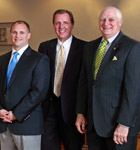Through the years, Richard Apfel has seen his share of incredible views. His favorite, by far, is the view of the Big Apple from the Empire State Building. “The view from our windows in the observation deck … they are just spectacular,” Apfel says. As president, Apfel helps Skyline Windows serve as a way of seeing nearly every breathtaking aspect of the New York skyline. Here, Apfel shares with Profile how the company is helping to create the windows that go beyond simple functionality to impacting the end user’s environment.
What was your upbringing like?
I grew up in Detroit during a time when there was a lot of social unrest. My high school days were a bit interesting (laughs). Let’s just say that the National Guard were our hall monitors. I played football and had the opportunity to attend a number of different schools and decided on Cornell University in New York. Having never been out of Michigan up until that point made going off to Cornell quite an interesting experience.
What were your interests back then?
I was majoring in engineering at the time. My timing was such that I ended up graduating during the (Jimmy) Carter days and the days of the oil embargos … energy was a big concern of everyone. Cornell had a large and quite prestigious hotel school in addition to a leading engineering school, and it was a matter of coincidence that I happened to be interviewed and eventually offered a job with Hilton Hotels and placed at the Waldorf Astoria. My main function there was to look at their energy-management systems and the overall operation of the building and determine how energy could be better saved.
These days, everyone talks about “going green,” but back in the 1970s, how did you and others approach the idea of energy savings?

There was really nothing being done at the time. Computers were still in their infancy in the 1970s. The use of computers to do computer modeling or to manage building-operating systems didn’t exist. We were starting at the bottom and looking to see how energy was being used in hotels. Basically, these hotels were commercial buildings being used in a residential way, so their use of energy was definitely unique. I wouldn’t say we were a pioneer, but it certainly wasn’t a concept on anyone’s mind. One of the big challenges is that in the hotel industry you never want to have a room out of order. Years later, I worked with the team at Skyline Windows to design a window-installation program at the Waldorf where we could go in and replace windows while the rooms were still being used. Essentially we would go in, remove the old window, install the new window, reinstall the window treatments, and the room could be re-rented the same night.
How did you first begin working with Skyline Windows?
From the Waldorf, I moved out to Beverly Hills [California]. During that time, the Kraus family expanded their building-restoration service to include window replacement and asked me to come and work for Skyline Windows. At the time, windows were a sideline to the main restoration company, but eventually the windows were our prime business.
How has the company evolved over the years?
We started two or three crews installing windows for individuals in their apartment. We would purchase windows from various manufactures from across the country. Eventually we began to manufacture our own windows to service the specific needs of our clients and our marketplace. Today, we ship our windows and doors across the country and have more than 100 installers in the field.
What are your day-to-day duties?
I used to work primarily in sales, but a year ago I took over the presidency. With my engineering background, I still spend much time helping layout projects, along with dealing with the day-to-day issues that come up in any construction company. We are probably on 20 jobsites on any given day. However, my main focus is to position Skyline Windows as an industry leader with the right products and services.
What inspires you?
Over the years I have been inspired with our ability to design and manufacture windows that were not available in the market answering the needs of New York-based designers and consumers. We are always focused on how the window will improve the end users environment and the aesthetics rather than just the functionality of the windows.

